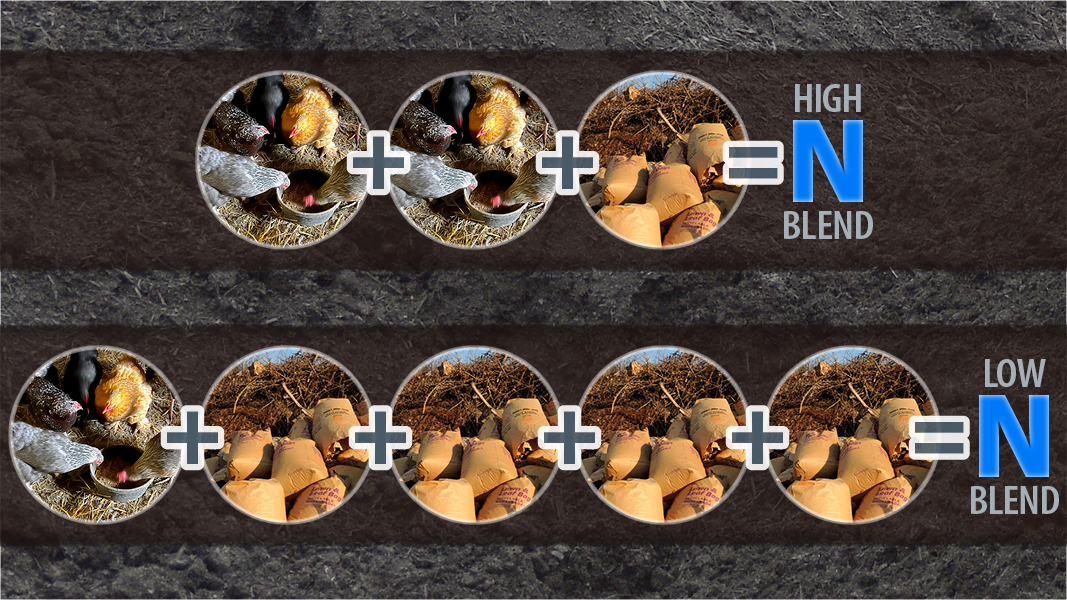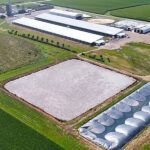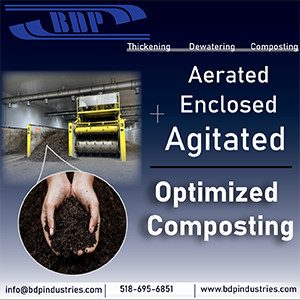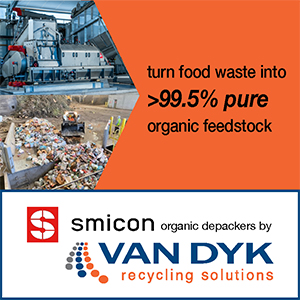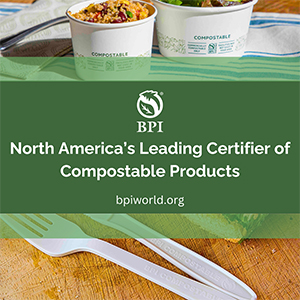Top: Low and high nitrogen recipes for making compost are illustrated. Image by Doug Pinkerton
 Sally Brown
Sally Brown
Can compost provide the full meal deal for crops? It depends. The short answer is that it typically should be considered more of an appetizer or amuse-bouche (a little teaser that fancy restaurants sometimes send out to start a meal) than the main course. It will never be equivalent to surf and turf and can sometimes provide only the nutrition of the extra fries on the side.
Think of this column as a menu guide for compost as a source of fertility for crops. First thing to know is that compost has a little bit for every palette. As a product of formerly living material, compost will contain all of the necessary macro and micronutrients necessary for plant growth. However, these will typically be in the organic form and not immediately available for plant or microbial use.
If the meaning of “organic forms” does not spring to mind, here is a quick translation. Nitrogen in the middle of a compound that also contains carbon is an organic form. Proteins are great examples. While we (and microbes) can eat protein, plants can’t. They only eat nitrogen (N) in a mineral form (nitrate or ammonia). The same way that we excrete out extra N (typically pee but also poop), microbes do as well. The extra N is typically excreted in a mineral form, ready for the plants to eat up. Depending on the feedstocks and how the compost is made, it may be too rich in carbon to allow for the microbes that eat it to release any additional nutrients to the soil. Remember in the soil dining hall, the microbes get first dibs. Only after they have had their turn at the compost buffet are the plants allowed a turn. Think of what the plants get as the “box” for the leftovers.
The primary nutrient required by plants and microbes and applied as fertilizer is nitrogen. You have to have the protein (N) to balance out the carbs (C). Compost will contain both organic N and mineral N. Mineral N is immediately available to plants. Ammonia (NH4) and nitrate (NO-3 ) are the two components of mineral N. Total N in compost is measured as a % value, aka parts per hundred. Mineral N is typically measured as mg kg or parts per million. For basics on the nitrogen cycle and how N is transformed look at the Connections column I wrote in 2016.
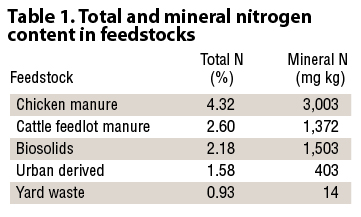 Certain feedstocks are richer in N and typically produce a compost with higher fertilizer value than others. However, the portion of these feedstocks in a mixture relative to higher carbon materials can impact the N availability of the final compost. Table 1 shows typical total N and mineral N concentrations of composts made with different feedstocks (Rynk et al., 2021).
Certain feedstocks are richer in N and typically produce a compost with higher fertilizer value than others. However, the portion of these feedstocks in a mixture relative to higher carbon materials can impact the N availability of the final compost. Table 1 shows typical total N and mineral N concentrations of composts made with different feedstocks (Rynk et al., 2021).
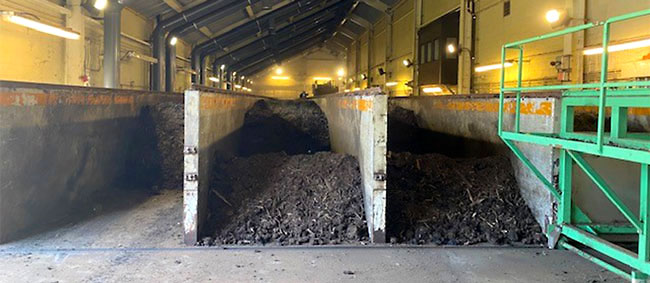
Composts made with biosolids — a single N-rich feedstock — can have total N and mineral N values that are all over the map (see Table 2). Photo of the Bennington biosolids composting facility by Jon D’Amour, courtesy City of Bennington, Vermont
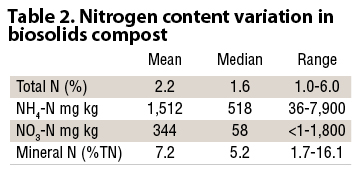 Table 2 illustrates how variable a compost made from a particular feedstock can be. This data is from Rigby et al (2016) on characteristics of biosolids composts. Values were taken from the peer review literature. Looking at composts made with biosolids — a single N-rich feedstock — you can see that total N and mineral N are all over the map.
Table 2 illustrates how variable a compost made from a particular feedstock can be. This data is from Rigby et al (2016) on characteristics of biosolids composts. Values were taken from the peer review literature. Looking at composts made with biosolids — a single N-rich feedstock — you can see that total N and mineral N are all over the map.
Calculating Plant Available N In Compost
The amount of the total N that will be plant available will vary based on characteristics of the compost and the soil and climate where it is used. There are a wide range of estimates in the literature, going from composts that tie up nitrogen to about 20% of total N available in the first year after application (Geisseler et al., 2021). A mean value for mineralizable N is 6.7% with a range of -10 (immobilization) to 24.5%. The Compost Handbook suggests 0% to 20% of total N will mineralize the first year after application. Most consider the C:N ratio of the material. One source said that with a C:N ratio < 25:1, N will be plant available. However, others show that lower ratios (14:1- 19:1) are required for N mineralization. Andy Bary, who co-led the composter training program for Washington State University, says 12:1 is an appropriate ratio. More N will be released in regions where temperatures are higher and rainfall is plentiful. Nitrogen also will be released in the years following application.
To translate this into practice, here are a few examples. For low potential N release and even potential N immobilization:
- Yard trimmings compost applied pretty much anywhere (yard waste is typically low in N)
- Compost with a C:N ratio of 18:1 applied in North Dakota where it is cold and relatively dry (slowing mineralization)
- Compost with a C:N ratio of 14:1 applied in Florida (where it is hot and wet and N will be rapidly mineralized and used up)
- Food scraps/yard trimmings compost that includes all of the C from Christmas trees (food/yard trim composts can vary over time in N availability)
- First application of 3 tons/acre of compost pretty much anywhere (a relatively low application rate of a material that is not ever that rich in N)
On the other side of the coin, here are some examples where compost is likely a reasonable source of N:
- Compost with some type of manure (including biosolids) as a feedstock (manures typically are high in N)
- Compost with a lot of food scraps in proportion to yard trimmings (food scraps are also typically rich in N)
- Compost with a C:N ratio < 12:1 (very low end of the C:N ratio suggesting higher N availability)
- Field where compost has been regularly applied over time to build up a reserve of soil N that is gradually released over time (N will mineralize over time, creating a rich reserve)
If you really want to get into the weeds on this, you can do a laboratory incubation (Gale et al., 2006). Here moist soil with amendment mixed in is incubated over time. The air is warm and flowing, allowing the microbes in the soil to do their work. The soil is sampled over time and mineral N (sum of nitrate and ammonia) is sampled periodically for about two months. This is a time consuming and more precise way to estimate N release than looking at the C:N ratio. It is also easiest to do if you have a soils lab and testing equipment — not quite as common in the home as a wide screen TV.
Protein Portions
On the other side of this menu is the fact that not all plants need the same amount of food to stay healthy. An annual corn crop harvested from the ground up will need a lot more food than a hydrangea. How much added protein (N) your plants need will depend on a range of factors. Extension bulletins often give equations to help you calculate how much fertilizer to add to a crop. Here is one from Cornell University:
Yield potential *1.2- SoilN-SodN)/ N efficiency/100
You start out by estimating how much yield you expect and the total N required to get there. You then take the available soil N and N from decaying plant matter (SodN). That first part of the equation gives you the total additional N required to meet your yield goals. That gets divided by how much of the N will actually end up in the plant — the N use efficiency. Nitrogen in soils is a very leaky system so not all of the N that you add will end up in the right place at the right time. If you are using an organic source of N here, that will add a layer of complexity to the equation. It is not impossible, far from it. It just requires time and patience and a bit of trial and error.
The point of all of this is to say that while many composts can provide N for plant growth, it is often not the main reason that a grower will use compost. If you do want to count on your compost for N, look at the label of ingredients and then check that C:N ratio. Also pack your patience. Nitrogen release from organics is not instantaneous. It takes weeks to months and then happens over years and multiple applications.
Sally Brown, BioCycle Senior Advisor, is a Research Professor at the University of Washington in the College of the Environment.


